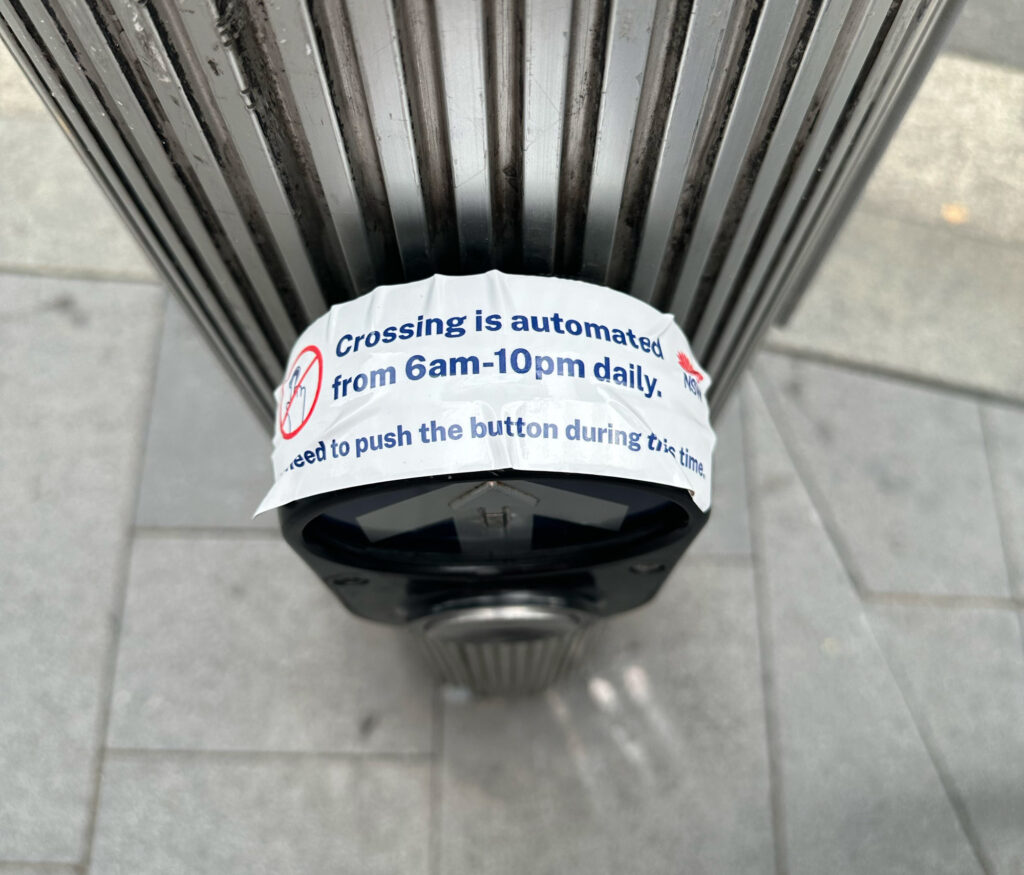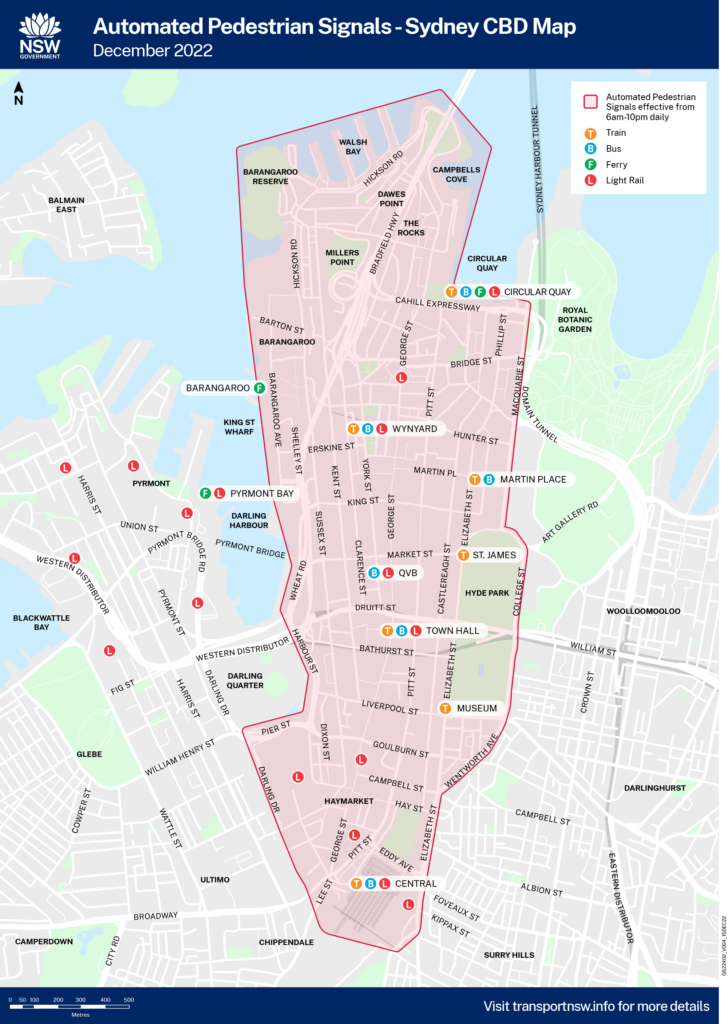See comments on Hacker News (85 comments) in the footer below and on Mastodon. See also recent posts: Shining a Light on the Traffic Signals of Sydney (July 2023) and Mapping pedestrian traffic light timing in Sydney, Australia (June 2023).

Transport for NSW (TfNSW) has recently installed these around the Sydney CBD – a sticker on top of a pedestrian “beg button” explaining the button must be pressed between 10pm and 6am. Not only does this sticker look like it will last a few weeks, but if you have to explain how something works, it isn’t designed well.
The Active Transport strategy recently released by TfNSW specifically states (on page 12) that key initiatives for metropolitan and urban areas include:
prioritising pedestrian movements at key destinations, including prioritising pedestrians at traffic lights
and
upgrading existing paths and streets for better walking and cycling experiences
This begs the question – if a key TfNSW initiative is to prioritise pedestrians in urban areas, and we’re prepared to automatically give pedestrians a green light every cycle during the day when car traffic volumes are highest – why not prevent the confusion and remove/cover the buttons permanently?
Even more perplexingly – we previously had fully automated buttons and they were accepted (if not widely celebrated by pedestrian & cycling advocates), so why go backwards?!
Fully automatic crossings during the pandemic
From March 2020, pedestrian crossings across the CBD were automated so that touch contact wasn’t required.
At first, no physical alteration was made, however behaviour is hard to change so signs like this were installed:

Eventually blue covers were affixed so pressing the button wasn’t possible, while audio-tactile feedback of the PB/5 units was left uncovered to assist visually-impaired pedestrians.

Not only a sensible decision to reduce physical contact during a pandemic (especially when virus transmission was less understood), you probably aren’t surprised that automatically guaranteeing pedestrians a traffic light cycle makes walking easier and faster.
In 2007, Copenhagen firm Gehl Architects wrote a report for the city of Sydney evaluating public spaces, which specifically highlighted the Australian phenomenon of prioritising motor vehicles at street intersections:
Push buttons are a widespread phenomenon all over Australia and in Sydney, where all crossings are supplied with push buttons. The installation of push buttons is part of State Government law. Here you have to apply to cross the street and if you press the button in time the digital device will give you between 7 and 10 seconds of green light to step off the kerb, before the lights start to flash red to tell you to finish walking across the road. Red periods are long, often lasting between 60 and 90 seconds. This system takes the elderly, children and people with disabilities hostages since they will often not be capable of moving across the streets at the pace needed. It also sends a clear signal that cars have higher priority than people.
Sydney – Public Space Public Life, 2007, Gehl Architects
TfNSW removing automatic operation
On Friday the 16th of December, Transport for NSW announced:
From mid-December 2022 Transport for NSW is removing the push button hard covers but maintaining the automation of pedestrian crossings at traffic signals during daytime hours. This is to reduce overnight noise for local residents and allow for more efficient intersection operation for all users when activity is low.
TfNSW Argument 1: More efficient intersection operation
Requiring manual pedestrian button operation does improve intersection operation for cars at the expense of all other modes.
However, car traffic volumes are lowest at nighttime and congestion is decreased, so intersection efficiently does not need to be ruthlessly prioritised at those hours.
Remember, the TfNSW Future Transport Strategy states (page 9):
We will focus on getting more out of our existing investments, by reallocating road space to more efficient modes of transport like buses, walking, cycling and micromobility devices.
and
Our vision for transport in NSW “We will stabilise traffic levels in Greater Sydney to improve productivity and manage congestion, ensuring we accommodate growth without sacrificing quality of life.”
So we now have in writing that TfNSW say that they are no longer prioritising traffic volumes at the expense of all else.
Sydney aspires to be a city with a vibrant nightlife, and there are often large pedestrian volumes late into the night and morning. Pedestrians at these hours are also most likely to be under the influence of alcohol and if inconvenienced, may be more likely to “jaywalk”
TfNSW Argument 2: Reducing overnight noise
Noise from the pedestrian buttons “activating” when pedestrians are allowed to cross is an interesting argument. I can emphasise with urban dwellers in noisy environments (I currently live in Inner Sydney), but the automated signal map covers few (if any) streets with low rise residential buildings – this is the centre of the largest city in Australia after all!

The National Cooperative Highway Research Program study Accessible Pedestrian Signals: A Guide to Best Practices, has been adapted by the NCHR into this online best practice resource. It states:
- All devices respond to ambient sound, both for the locator tone and the WALK indication.
- APS [Accessible Pedestrian Signals] are sometimes turned off at night due to neighbors’ complaints about noise.
This implies that the the noise produced is lower at nighttime when there is less traffic noise, and there is already a precedent for pedestrian signals being turned off selectively at nighttime due to noise concerns.
Perhaps it makes more logical sense that only those pedestrian buttons that receive complaints should be set to manual overnight, with a prominent & permanent sign rather than a sticker.

Globally our little PB/5 units are so beloved that they’ve even been bestowed with a Grammy, their design so ubiquitous with simplicity that their main job is to almost blend into their environment, so why not let them and save them from our grubby fingers?
With a simple software update, that was already successfully tested during the pandemic, we can improve the walkability in the City of Sydney – and with any luck, everywhere else!
(…and after that, shorten cycle times and improve light phasing)
Leave a Reply